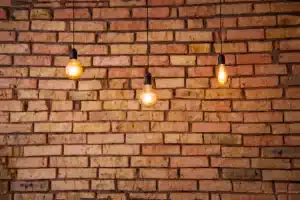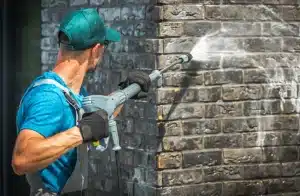White stains on brick, known as efflorescence, occur when moisture draws salts to the surface. This guide will help you understand what causes these stains, how to effectively remove them, and the steps you can take to prevent them from coming back.
Key Takeaways
- Efflorescence, caused by soluble salts and moisture, manifests as white stains on brick and other masonry materials. It affects aesthetics without damaging the bricks.
- Preventing efflorescence involves good construction practices such as proper drainage, dense mortar joints, and the application of hydrophobic sealers to minimise moisture ingress.
- Environ Restoration Services can help remove the stains and also address the root causes, ensuring your brickwork stays clean and protected for the long term.
What are the White Marks On My Bricks?
The white marks on your bricks are called efflorescence. While the term might be unfamiliar, its appearance is common. These white, powdery stains form when moisture draws out soluble salts, including calcium carbonate, from the bricks. As the water evaporates, it leaves behind these salt deposits, creating the noticeable white marks.
These white marks can appear on various building materials like:
- brick
- mortar
- concrete
- stone
This makes them a frequent issue in masonry and the construction industry.
Soluble salts in building materials are the main cause of these unsightly stains. When moisture dissolves these salts, it carries them to the surface. As the water evaporates, the salts crystallise, leaving behind a white residue. This can happen on both new and old walls, especially after exposure to water or moisture, including calcium sulfate.
It’s important to note that while efflorescence can be unsightly, it doesn’t harm the structural integrity of the bricks. However, it can detract from the appearance of your home or building and may lower its value.
Causes of Efflorescence on Brick
Efflorescence happens when moisture gets into your brick walls. Rainwater, groundwater, or even high humidity can introduce moisture into the brick, which starts the process. Once water seeps in, it dissolves the soluble salts within the brick. As the water evaporates, these salts crystallise on the surface, leaving behind those telltale white stains.
Leaks from damaged masonry or poorly designed drainage systems can worsen this problem. Even construction materials like bricks and mortar that get wet before installation can lead to efflorescence. That’s why protecting your materials from moisture during construction is so important. To effectively address white stains on brickwork, consider our professional brick cleaning solutions tailored to restore your property’s aesthetic appeal.
Good construction practices are the foundation of efflorescence prevention.
Effective Methods to Remove Efflorescence
There are several ways to remove efflorescence, depending on how severe the problem is. For minor cases, you can often tackle it with a stiff bristle brush. Just make sure the surface is completely dry before you begin. It’s important to remember that removing the white stains isn’t just about cleaning—it’s about fixing the source of moisture. If you don’t address the underlying dampness, the problem will keep coming back.
For tougher stains, you may need to use stronger solutions like muriatic acid. Be sure to follow safety guidelines and wear protective gear when using these products, as they can be hazardous if not handled properly.
If the efflorescence covers a large area, power washing can be a good option, especially for exterior walls. Just be careful not to damage the bricks. It’s best to use a salt neutraliser for internal walls to safely remove the stains. Ultimately, the most important step is stopping the moisture that’s causing the problem in the first place.
If you’re dealing with persistent or extensive efflorescence, our team at Environ Restoration Services is here to help. With our expertise, we can not only remove the stains but also address the root causes, ensuring your brickwork stays clean and protected for the long term.
Household Remedies for Small Areas
Household remedies can be economical and effective for small areas affected by efflorescence. A simple mixture of 50/50 white vinegar and water can work wonders on minor efflorescence issues. This method leverages the mild acidity of vinegar to dissolve the salts without damaging the brick surface.
Combine white vinegar and water equal parts, apply to the affected area, and scrub gently with a stiff brush. This method suits most minor efflorescence cases, making it convenient for homeowners.
Household remedies save money and provide a quick solution to minor efflorescence problems. They are easy to prepare and apply, allowing prompt issue resolution and maintaining brickwork appearance.
Professional Cleaning Solutions
When dealing with severe efflorescence, it’s often best to bring in a professional cleaning service. Experts can thoroughly assess your building, identifying the underlying causes of the issue, which is key to developing an effective treatment plan.
Professionals use advanced techniques to remove stubborn salt deposits, making them ideal for large-scale restoration projects or extensive efflorescence. They don’t just eliminate the visible stains—they also tackle the root cause, helping prevent future outbreaks. With specialised products and equipment, professionals ensure a safe, efficient job that preserves the integrity of your brickwork.
At Environ Restoration Services, our expert team is ready to help you restore your brick surfaces and protect them from future issues. Contact us today for a reliable, long-lasting solution!
Why Choose Environ Restoration Services?
At Environ Restoration Services, we specialise in restoring brickwork with precision and care. Our team of experts has extensive experience in tackling efflorescence and other masonry issues, using advanced techniques that not only remove visible stains but also address the root causes. This ensures long-term results and prevents recurring problems.
We understand that every building is unique, which is why we offer personalised solutions. From heritage buildings to modern structures, our restoration approach is customised to meet your specific needs. We use top-of-the-line products and equipment, ensuring that your brickwork is not just cleaned but fully protected from future damage. With our in-depth assessments and professional-grade tools, we handle projects of all sizes efficiently and safely.
We pride ourselves on delivering the highest standards of workmanship and maintaining the beauty and integrity of your building. Our reputation for reliability, punctuality, and exceptional customer service sets us apart in the industry. Contact Environ Restoration Services today for a consultation.
Preventing Efflorescence Recurrence
Preventing efflorescence from coming back is not only more effective but also more cost-efficient than constantly removing it. The key to a long-term solution lies in good drainage design, which helps avoid moisture buildup in brick structures. By properly designing drainage systems, you can redirect water away from your building and minimise the risk of moisture infiltration.
Temperature fluctuations play a significant role in how moisture moves within bricks, often leading to efflorescence. To combat this, consider using dense mortar joints and other construction practices that reduce material porosity. Additionally, applying a sealant after addressing existing efflorescence will further protect your masonry from water and salt absorption, keeping your bricks looking their best.
If you find yourself dealing with persistent moisture issues, seeking the help of a specialist for waterproofing measures is advisable. For instance, installing vapour barrier sheeting can effectively prevent water and salt absorption in masonry, providing added protection against efflorescence. Here are some essential strategies you can implement:
- Install gutters and flashings to minimise water ingress.
- Use dense mortar joints to reduce porosity and limit water and salt movement.
- Apply a hydrophobic sealer to prevent water absorption in masonry.
- Ensure proper drainage systems to redirect water and prevent moisture accumulation.
- Opt for low-absorption concrete to further decrease the risk of efflorescence reappearing.
By implementing these practices, you can effectively prevent efflorescence in your construction projects and maintain the beauty of your brickwork for years to come.
Frequently Asked Questions
What causes efflorescence on brick walls?
Efflorescence on brick walls is caused by soluble salts that are drawn out by moisture and deposited on the surface as the water evaporates, leaving behind white powdery stains.
What causes salt deposits on bricks, and how can I remove efflorescence?
Salt deposits form when excess water causes soluble salts to migrate to the surface. This often happens due to a water leak. Once the water has evaporated and the surface is completely dried, it leaves behind a white powder. For removing efflorescence, it’s essential to fix the water leak first; otherwise, more salts may accumulate.
What services does Environ Restoration Services offer?
At Environ Restoration Services, we provide comprehensive solutions such as heritage building restoration, brick repointing, paint removal, and damp proofing. Our expertise ensures thorough and careful attention to various restoration needs.
Conclusion
Efflorescence, those unsightly white stains on brick walls, can be effectively managed with the right knowledge and tools. The first step is to understand the causes, such as moisture infiltration and soluble salts. You can restore the beauty of your brickwork by employing effective removal methods, whether through household remedies or professional cleaning solutions.
Preventing the recurrence of efflorescence is crucial. Good drainage design, temperature control, and the use of sealants and vapour barriers can go a long way in keeping your bricks stain-free. Professional waterproofing measures are recommended for persistent issues.
Environ Restoration Services stands ready to assist with expert restoration and maintenance, ensuring that your buildings remain both beautiful and structurally sound. Our blend of traditional craftsmanship and modern technology makes us a trusted partner for all your restoration needs.




